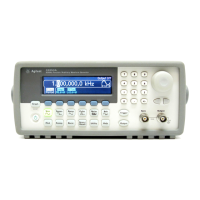302
Chapter 7 Tutorial
Signal Imperfections
7
Signal Imperfections
For sine waveforms, signal imperfections are easiest to describe and
observe in the frequency domain using a spectrum analyzer.
Any component of the output signal which has a different frequency
than the fundamental (or “carrier”) is considered to be spurious.
The signal imperfections can be categorized as harmonic, non-harmonic,
or phase noise and are specified in “decibels relative to the carrier level”
or “dBc”.
Harmonic Imperfections Harmonic components always appear at
multiples of the fundamental frequency and are created by non-linearities
in the waveform DAC and other elements of the signal path. The 33250A
uses a 100 MHz low-pass filter to attenuate very-high-frequency
harmonics. At lower frequencies and low amplitudes, another possible
source of harmonic distortion is due to the current flowing through the
cable
connected to the function generator’s
Sync
output connector.
This current
can cause a small square-wave voltage drop across the
resistance of the
cable’s shield and some of this voltage can be imposed
on the main signal
. If this is a concern for your application, you should
remove the cable or disable the
Sync
output connector. If your application
requires that you
use the
Sync
output connector, you can minimize the
effect by terminating
the cable in a high impedance load (rather than into
a 50Ω load).
Non-Harmonic Imperfections The biggest source of non-harmonic
spurious components (called “spurs”) is the waveform DAC. Nonlinearity
in the DAC leads to harmonics that are aliased, or “folded back”, into the
passband of the function generator. These spurs are most significant
when there is a simple fractional relationship between the signal
frequency and the function generator’s sampling frequency (200 MHz).
For example, at 75 MHz, the DAC produces harmonics at
150 MHz and
225 MHz. These harmonics, which are 50 MHz and 25 MHz
from the
function generator’s 200 MHz sampling frequency, will appear as spurs
at 50 MHz and 25 MHz.
Another source of non-harmonic spurs is the coupling of unrelated signal
sources (such as the microprocessor clock) into the output signal.
These spurs usually have a constant amplitude (
≤
-75 dBm or 112 µVpp
)
regardless of the signal’s amplitude and are most troublesome at signal
amplitudes below 100 mVpp. To obtain low amplitudes with minimum
spurious content, keep the function generator’s output level relatively
high and use an external attenuator if possible.

